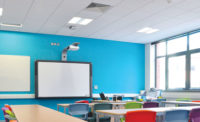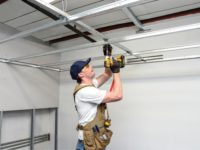With occupant health and well-being at the forefront of designers’ and specifiers’ minds, mineral fiber ceiling panels retain a long-established foothold in the industry. As the original “all-around solution” for acoustical comfort, suspended mineral fiber has also become the design standard for hospitals and medical facilities, because of their durability, ease of installation and chemically-cleanable finished surfaces.
Today, contractors are being called upon to rapidly retrofit medical facilities. Mineral fiber is the ideal product for quick modular construction, because it supports the changing needs hospitals are facing due to COVID-19.
Working with mineral fiber is usually straightforward—a reason why it is chosen for quick installation projects. But knowing your way around the various mineral fiber products and their characteristics will make for easy and, as such, quicker installations. Here is some expert advice on how to keep mineral fiber projects running productively, while reducing callbacks and keeping labor costs down.
Know What Options Are Available
There are fewer bumps in the road when contractors know the product well. Manufacturers offer a variety of options in mineral fiber panels. Knowing which products work most effectively in specific environments and installations means contractors will make recommendations to specifiers that save them the most time and money.
All mineral fiber panels are easily cut to size on-site when modifications are required. However, it’s important to know which products are easiest to cut, produce minimal dust, and are less prone to chipping or being dented during installation. In fact, some high-durability panels are even puncture and scratch resistant. Job sites are active environments and products are often moved around rooms and between floors. It’s therefore important to work with panels that will hold up to being moved repeatedly to eliminate product waste from damage—an especially important product trait when the ceiling is installed before other stages of the fit-out. Durable panels produce less waste, require less cleanup of dust, and necessitate fewer callbacks.
Less product waste is a benefit of panels with chemically-cleanable surfaces, as well. Panels frequently get smudged during the construction process either by the installers or other trades whose work necessitates access to the space above the ceiling. A soiled or smudged panel face distracts from the clean, uniform appearance that designers and owners expect. To prevent having to replace those dirty ceiling panels before end-of-project walk-throughs, research which ceiling panels are able to be cleaned, and whether or not common sanitizers and/or cleaning solutions can be implemented.
Beyond researching the panels, themselves, contractors be aware of additional products that will save time and decrease costs. Manufacturers produce accessories for suspension systems that expedite mineral fiber panel installation, such as special yokes that facilitate the introduction of linear lighting and HVAC diffusers in the ceiling system Knowing the nuances of how these systems integrate translates into saving time, increasing speed, and ultimately saving money.
Don’t Be Afraid to Ask Questions
Research frequently leads to questions. When an installer is learning about a new product, it is essential to seek out answers. And you shouldn’t have to look any further than the manufacturer.
Most manufacturers offer product and installation webinars, as well as technical personnel for one-on-one discussions that are often necessary to address project-specific questions. For more detailed assistance, field specialists make on-site visits to conduct hands-on training and walk contractors through the initial phases of the job.
These additional support measures help instill confidence in selecting and installing the correct product efficiently.
This open communication between manufacturer and contractor is also important as products improve. Representatives will contact the contractor directly to inform them of physical product changes and installation advancements.
Frequently, updates are made to products because contractors asked questions and expressed opinions. By asking questions and sharing observations, contractors direct much of the innovation implemented by manufacturers in their constant evolution of the product offering.
Look for Manufacturers Who Take Input from the Field
From aesthetics and acoustical comfort to ease of installation, mineral fiber continues to evolve. And manufacturers think beyond the occupants’ health and well-being when anticipating future needs.
By researching ways to reduce panel weight without diminishing acoustical performance, there is hope to positively affect the potential for injury caused by repetitive movements during installation.
Along with lightening the weight of the material, manufacturers are looking toward making mineral fiber more customizable. At first, this may not seem like an important trend to contractors, but it affects project timelines.
Customized products will be produced specifically for a project and won’t be readily available in a warehouse, it’s important for contractors to be aware of this potentially longer timeline.
Contractors with a finger on the pulse of the industry know when advancements occur, and timelines are affected. This knowledge allows them to bid jobs realistically and set expectations from the beginning for the project.
Leverage a Trusted Partner
Mineral fiber is a time-tested, well-known product, but it’s never good to assume that just because a product category has been around for decades that all products within it are created equally or that you shouldn’t reach out to manufacturers to help solve installation challenges. Manufacturers are an excellent resource that want to be utilized. Whether quickly retrofitting an existing facility or taking part in new construction, contractors who conduct research, ask thoughtful questions, and prepare themselves to assimilate innovative product advancements, will continue to lead successful, productive projects.











